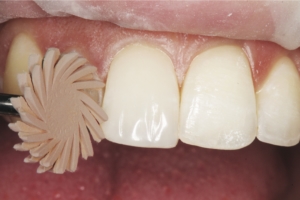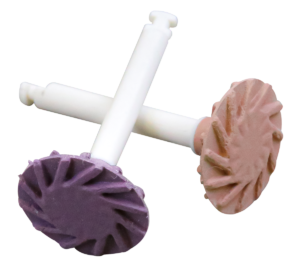Improve the Overall Quality of your Composite Restorations
Douglas, Harvey, B.Sc., D.D.S.
Today’s composites have led to improved overall esthetics with direct composite restorations. However, these materials continue to rely on the effective polishing of the restoration to optimize the esthetic potential of the composite itself. Regardless of the finishing techniques or instrumentation used to contour, reduce, and establish surface characterization, polishing remains integral to achieving clinical esthetic success. As with all aspects of dental treatment, your chosen dental materials will have a direct impact on the overall quality of the composite restoration.

Dentistry and photography courtesy of Daniele Larose, D.D.S.
A thorough and efficient high luster polish is necessary to take advantage of the optical properties of the composite to mimic the adjacent natural tooth surface using minimal procedure time. Stain and plaque resistance, not to mention patient comfort, are important intended outcomes achieved with a highly polished restoration. The ideal polishing system must not only attain the highest luster possible, but would also consider the clinical efficiencies that minimize chair time which benefits both patient and dentist, reduce office inventory, and produce predictably high esthetic outcomes.
The criteria for selecting the ideal polishing system would include its ability to produce a very high luster on all types of composite resins, both in the anterior and posterior, regardless of the surface of the tooth. It should accomplish this in a short period of time with the fewest steps, shapes and sizes and ideally withstand multiple sterilization cycles. This list sounds extensive however the result would be a highly effective and highly efficient system, reducing both chair time and polisher inventory.
First, the ideal polishing system would be appropriate to use on the widest variety of composites. No longer would microfills, microhybrids, and nanohybrids require separate polishing systems to bring out their highest shine. Additionally, its versatility would also apply to the polishing of other substrates such as temporaries and ceramic restorations. Temporary restorations and adjusted ceramic restorations benefit from a highly polished surface for the very same reasons as composite restorations. A polishing system based on diamond particles would provide more flexibility for use on other restorative substrates. This convenience would decrease or even eliminate the need to stock separate polishers for other substrates that often benefit from chairside polishing.
Minimizing chair time is directly related to technique efficiency. Almost all features of the ideal polishing system influence the overall time taken to produce the ultimate polish. It begins with the length of time each polisher has to be in contact with the composite surface during each step of polishing.
The less time required on the tooth before progressing to the next polishing step results in a reduction in overall treatment time. Of course, reducing the number of polishing steps needed to achieve a high luster is also a pertinent consideration when choosing a predictable and efficient polishing system. Along with the length of time each polisher is used on the composite surface, reducing the number of steps to change the polishing grits results in less polisher changes, saves valuable chair time, and can result in less inventory.

Reducing chair time without compromising restorative quality and patient experience, is the most important factor contributing to clinical efficiency and its relationship to generating better profitability. Initial product cost and replacement costs must also be considered when choosing a polishing system. Single-use polishers are very convenient for set-up and take-down but can be an expensive alternative to multi-use polishers and require much more inventory control. Ideal multi-use polishers would need to be robust enough to withstand multiple uses and repeated sterilization cycles without diminished clinical performance regardless of the number of cycles experienced.
The polishing of a well-designed, placed, and contoured composite restoration need not be a lengthy, multi-step regimen nor should its importance be diminished in any way in favor of saving time. It is possible for this crucial step of your composite technique to be accomplished as meticulously as the preparation, placement, and contouring with minimal steps and instrumentation.
